South Coast, UK
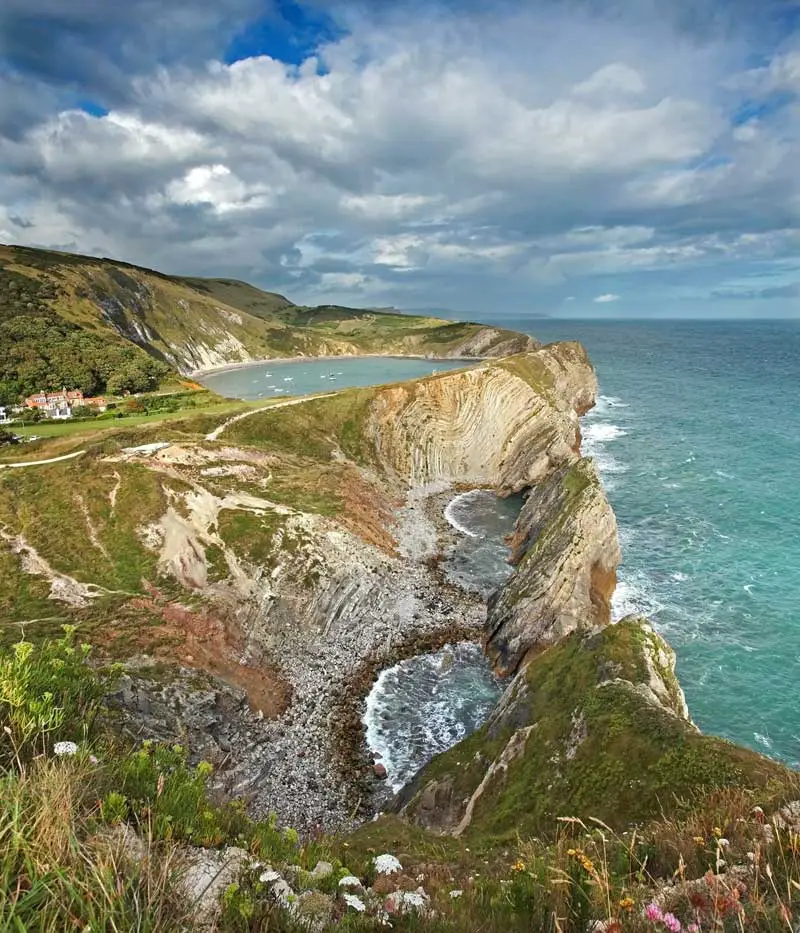
Lulworth Cove and Stair Hole
England’s South Coast claims to be the sunniest place in the UK. It boasts seven international gateways providing easy access from Europe by air, rail, ferry or cruise ship, over 300 miles of coastline, two National Parks and four World Heritage Sites. The South Coast also boasts many iconic locations like Stonehenge, Spinnaker Tower and the Brighton Pavilion. New in Brighton, the British Airways i360 is the world’s tallest moving observation tower boasting views of up to 40 km.
The castles alone offer a glimpse of England from William the Conqueror and earlier. The three castles he built at Dover, Canterbury and Rochester can still be seen. Dover Castle was begin in 1066, but finished by Henry II in 1170. Garden hunters will enjoy Scotney Castle. Considered to have one of the best gardens in the country, it surrounds the moated ruins of the 14th century castle.
It plays host to some of the UK’s most legendary music and arts festivals and has a rich maritime heritage unrivalled anywhere in the world. The rolling countryside and magnificent coastline offers great opportunities for walking and cycling enthusiasts. For lovers of food and drink discover the best of British vineyards producing wines that rival those found in the Champagne region of France or indulge in locally produced beer and food at some of the great country pubs .
With all that going for it, you know England’s South Coast is going to be well worth visiting and spending time there, but so too do the millions of people who live in southern England. This is their regular holiday and recreation playground so expect plenty of people to be sharing the beaches and resort towns with you, especially during the warmer months. Book any accommodation you require during Summer at least six months in advance.
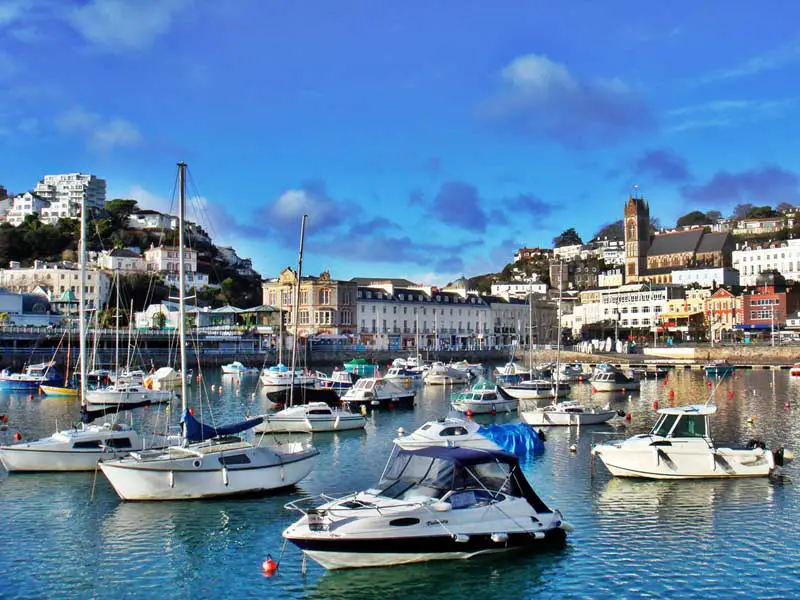
Torquay
South Coast: Southampton to Plymouth UK
This journey can be made by train or by car. By train, travelling from Southampton to Plymouth takes four hours without stops, but follows an inland ruote, bypassing all the coastal towns visited here. Dawlish, Taignmouth, Paignton and Torquay can be accessed from Exeter via a branch line. The Weymouth train from Southampton visits most of the destinations listed here between Southampton and Weymouth.
There are numerous options if travelling by road which alter the distance travelled and time taken considerably. To visit every destination listed, you would need more than a single day to make the journey, as you would be covering over 350 km on a journey that would take around 7 hours without stops. Driving direct from Southampton to Plymouth takes 4 hours (260 km) but touches verry little of the coast. Deviations to include coastal destinations between Bournemouth and Exmouth will add at least an hour’s driving plus stops, as would including Torquay and coastal towns to its south instead of driving inland from Exeter to Plymouth.
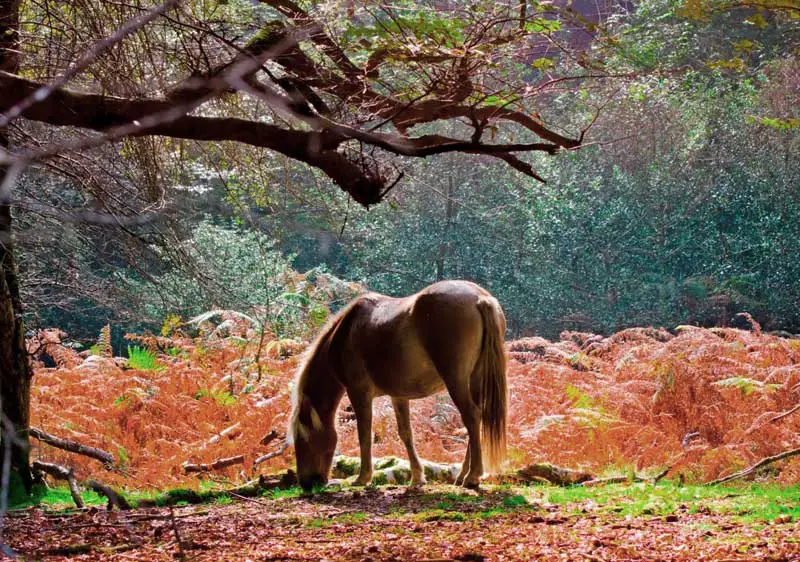
New Forest
The New Forest is an area of southern England which includes one of the largest remaining tracts of unenclosed pasture land, heathland and forest in the heavily populated south east of England. It covers southwest Hampshire and extends into southeast Wiltshire and towards east Dorset. There was still a significant amount of woodland in this part of Britain, but this was gradually reduced, particularly towards the end of the Middle Iron Age around 250-100 BC, and most importantly the 12th and 13th centuries, and of this essentially all that remains today is the New Forest. There is a wealth of places to visit and explore in the New Forest from award winning gardens, museums, leisure and wildlife parks plus much, more. Each season provides a change of scene from the rich deep colours of spring and summer to the seasons of mists and mellow fruitfulness.
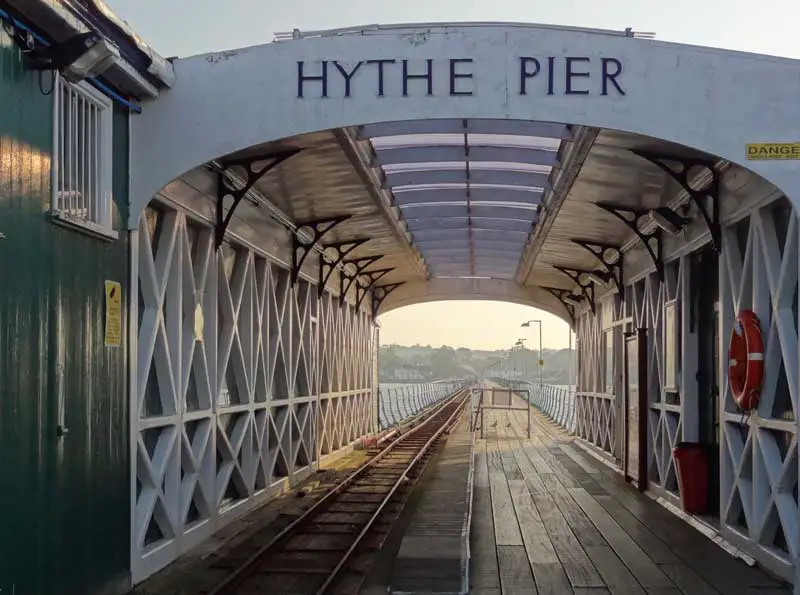
Hythe
Enjoy a panoramic view of the boats and passing ocean liners from stylish Hythe Marina or walk around the attractive Victorian and Georgian buildings. Along one of the ten longest piers in the British Isles runs the oldest operating pier train in the world. The electric locomotives that do all the work (built in 1917) were originally commissioned for operation in a mustard gas factory during the First World War. In the 1930s, Hythe was home to the British Powerboat Company and TE Lawrence (Lawrence of Arabia) once lived in the village. Hythe is also the birthplace of the hovercraft, invented by Sir Christopher Cockerill.
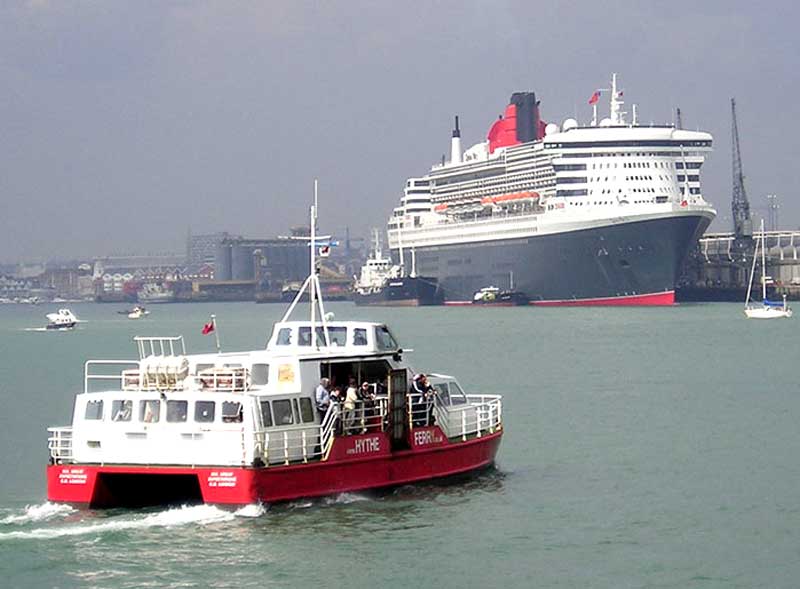
Being opposite Southampton, Hythe has witnessed some legendary maiden voyages such as the Titanic in 1912, the QE2 and, more recently, the superliners.

Beaulieu
Beaulieu, in the heart of the New Forest, is one of the UK’s leading Tourist Attractions. It offers a great family day out with many attractions to discover. At Beaulieu you’ll find the National Motor Museum (entry fees apply), the Palace House, home of the Montagu family since 1538, and Beaulieu Abbey with its exhibition and film of monastic life. Visit the Secret Army Exhibition, telling the story of wartime Beaulieu and the training of secret agents. The National Motor Museum is home to 250 vehicles, telling the story of motoring from World Land Speed Record Breakers to Formula 1 racers. Take a ride on ‘Wheels’; a pod ride journey taking you through 100 years of motoring, and visit Jack Tucker’s Garage, which recreates the sights, sounds and smells of a typical country garage from the 1930s. As well as this, take a ride around the attraction on the high-level Monorail or see the sights from the replica 1912 open-topped London Bus. World of Top Gear features the actual cars from the most ambitious challenges over the years on BBC TV’s motoring show, Top Gear.
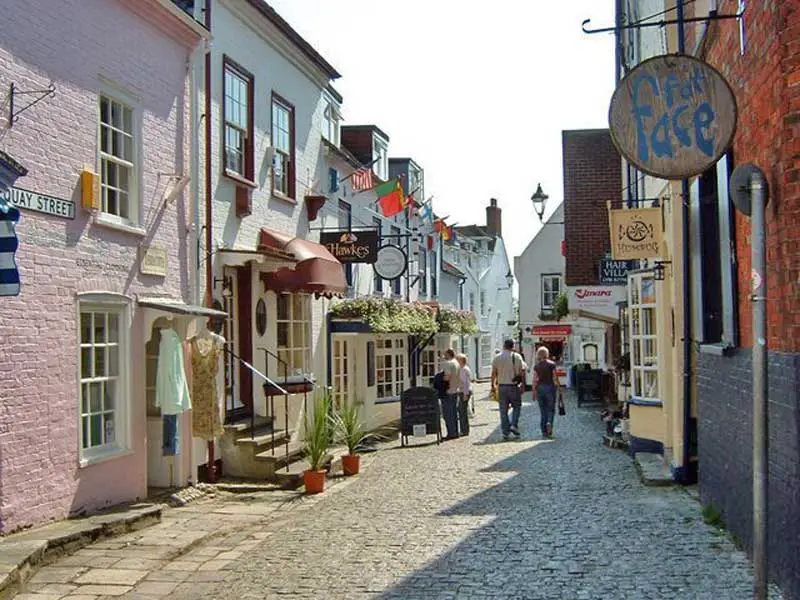
Lymington
Lymington is a Georgian market town and port on the west bank of the Lymington River on the Solent, in the New Forest district of Hampshire. The town’s narrow streets are lined with pretty period cottages and houses, as well as plenty of local pubs and restaurants. Lymington High Street has several independent shops and designer boutiques, as well as a local market held each Saturday which dates back to the 13th century. Lymington is surrounded by the beautiful countryside of the New Forest, where opportunities for outdoor activities are abundant. The Solent Way footpath provides a great coastal walk with fantastic views of the Needles and the Isle of Wight. Located just outside of the town is the Wightlink ferry port, from which a car ferry travels to Yarmouth on the Isle of Wight.
Lymington High Street was also home to Captain Arthur Phillip RN, First Governor of New South Wales and founder of Sydney, when he returned to England from Australia. While in Lymington he was promoted to Rear Admiral and commanded the Sea Fencibles and the Pressgang Service for the whole of England.
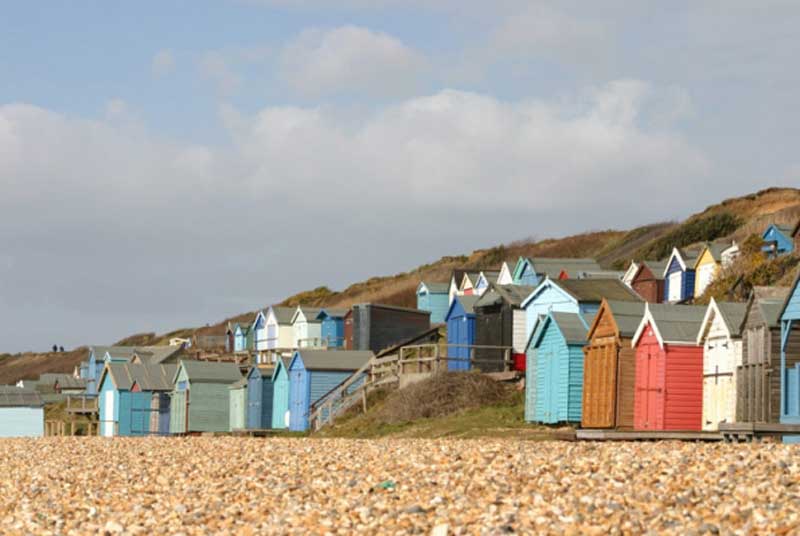
Milford-on-Sea
Charming Milford-on-Sea and neighbouring Keyhaven both enjoy stunning sea views towards Christchurch Harbour. The traditional village offers a range of shops, cliff top walks and beaches. There are relaxing pubs and restaurants and a good choice of visitor accommodation, from camping sites to hotels. Nearby Hurst Castle has a long military history, dating from Tudor times when it was built by Henry VIII to defend the Solent. It was the prison of Charles I and is now owned by English Heritage.
The tranquility of the 70 km stetch of New Forest coast and the inaccessibility of much of the foreshore are what keep the wildlife coming back. This includes wildfowl, egrets, herons, birds of prey and, of course, the famous New Forest Ponies who can occasionally be glimpsed rolling in sand-patches on our isolated beaches.
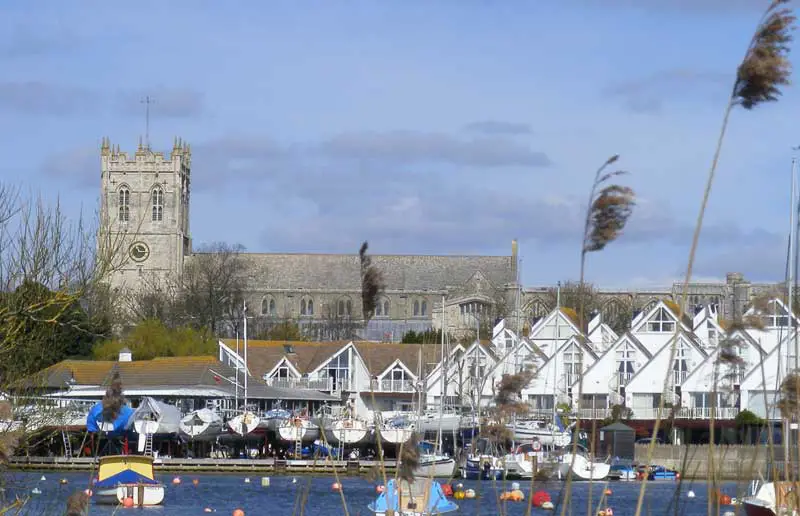
Christchurch
The Dortset town of Christchurch adjoins Bournemouth in the west and the New Forest lies to the east. The town’s harbour, beaches, nature reserves and historically important buildings have made Christchurch a popular tourist destination attracting some 1.5 million visitors a year. Every year since 2000 the town has held a food and wine festival during May. It includes an international food market with over 100 stalls selling food and drink, and a large marquee with a kitchen area erected in Saxon Square. Christchurch holds an annual music festival on the first weekend in July. Another annual event is the regatta which has been held every year since 1909 in August.
Christchurch Castle is of Norman origin and was originally of a motte and bailey construction. The castle once dominated the town but now lies in ruins and only a couple of the keep walls remain. Christchurch town centre and the Harbour are overlooked by the 11th century Grade I listed Christchurch Priory. Once a monastery, it was given to the town for use as a parish church by Henry VIII after the dissolution in 1540. Place Mill is an Anglo-Saxon watermill located a short distance to the south of the Priory on Christchurch Quay. It is mentioned in the Domesday Book and features a mediaeval stone base underneath red brickwork. Situated on the cliffs at Highcliffe is Highcliffe Castle. The building was designed by William Donthorne for Charles Stuart, 1st Baron Stuart de Rothesay, and built between 1831 and 1835.
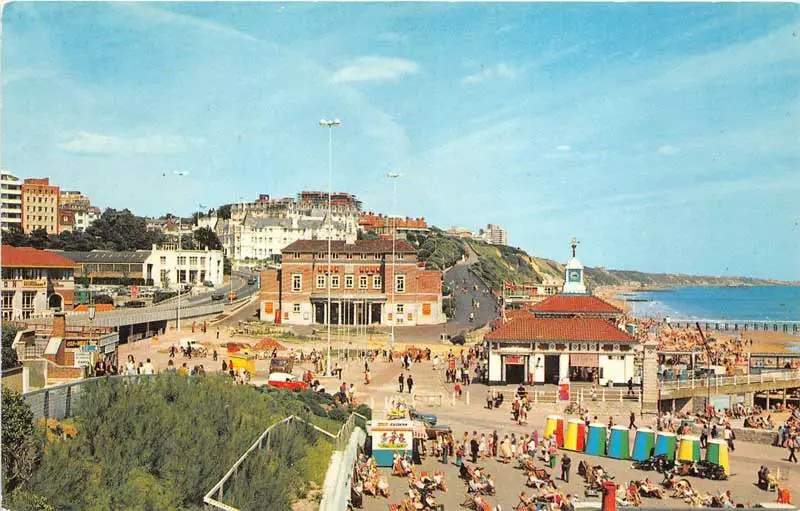
Bournemouth
The large seaside resort of Bournemouth is known for its 13 km of beaches, Victorian architecture and buzzing nightlife in areas such as the Triangle. The resort is also home to Bournemouth Pier, an activity centre with an obstacle course, a climbing wall and a zip line. It is a very popular destination for tourists, attracting over five million visitors annually. Bournemouth seafront is one of the UK’s biggest attractions with 4.5 million visitors in 2011. Bournemouth has more than 200 heritage listed buildings, mainly from the Victorian and Edwardian eras, including three grade I churches; St Peter’s, St Clement’s and St Stephen’s. With a third of all town centre businesses in the leisure industry, Bournemouth has a booming nightlife economy and is a popular destination for stag and hen parties.
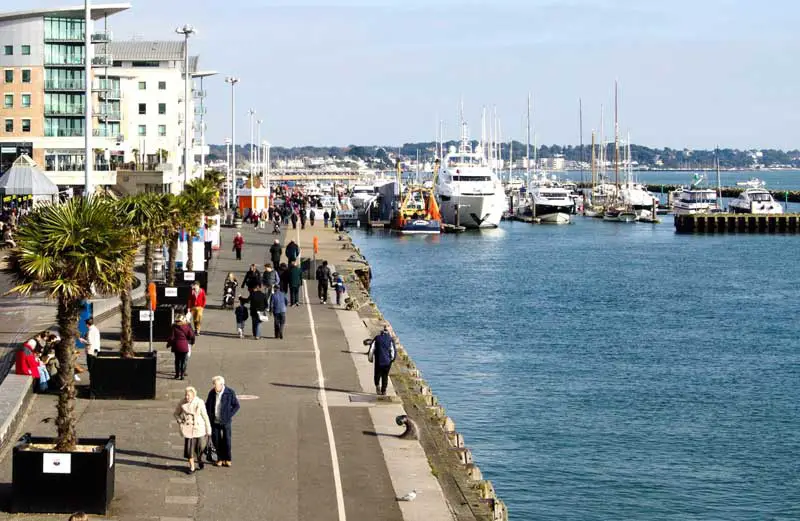
Poole
The large coastal town and seaport of Poole in the county of Dorset, 33 kilometres east of Dorchester, and adjoins Bournemouth to the east. Poole promotes itself as ‘The Coast with the most’, and there is certainly plenty for the visitor to see aqnd do up and down the coast. Poole Quay is a visitor attraction to the south of the town centre lined with a mixture of traditional public houses, new bars, redeveloped warehouses, modern apartment blocks and historic listed buildings. Once the busy centre of Poole’s maritime industry, all port activities moved to Hamworthy in the 1970s as the Quay became increasingly popular with tourists. Boats regularly depart from the quay during the summer and provide cruises around the harbour and to Brownsea Island, the River Frome and Swanage. Poole’s sandy beaches are a popular tourist destination extending 4.8 kilometres along Poole Bay from the Sandbanks peninsular to Branksome Dene Chine at the border with Bournemouth.
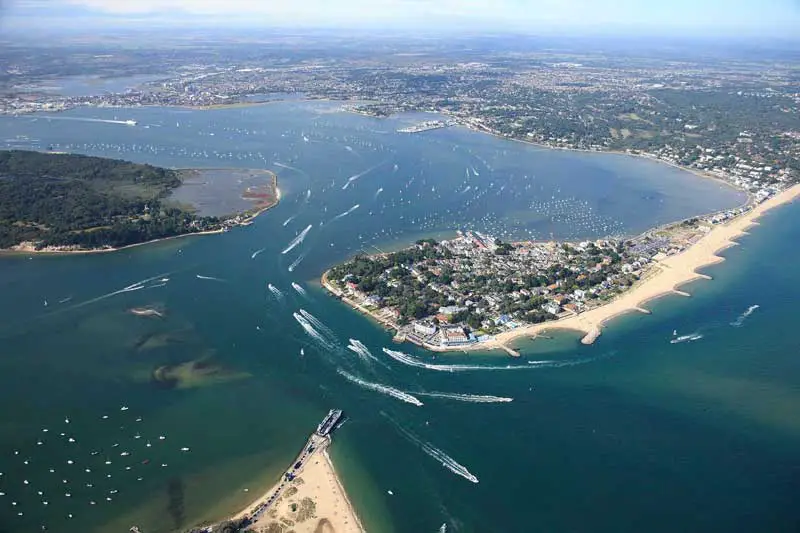
Poole harbour is the largest natural harbour in Europe and the claimant of the title of second largest natural harbour in the world after Sydney Harbour. Poole Harbour and Poole Bay are popular areas for a number of recreational pursuits, including sailing, windsurfing, surfing, kitesurfing and water skiing. The harbour’s large areas of sheltered waters attract windsurfers, particularly around the northern and eastern shores. Water skiing takes place in the harbour in a special designated area known as the Wareham Channel. The waters around the harbour, Poole Bay and Studland Bay are also popular for recreational angling and diving.
Poole has four railway stations on the South Western Main Line from London Waterloo to Weymouth. Poole is a cross-Channel port for passengers and freight. Ferry services from Poole Harbour to Cherbourg are provided by Brittany Ferries who operate one round trip per day using the Barfleur. The Condor Ferries catamarans Condor Express and Condor Vitesse run seasonal services to Guernsey, Jersey and St. Malo, Brittany.
Poole is the gateway to the Purbeck District in south Dorset. It is home to some of the country’s most well-loved towns and landmarks including Swanage, Lulworth Cove, Corfe Castle and Durdle Door. The Isle of Purbeck is part of the district, being a peninsula connected by road rather than a separate island. On Purbeck’s boundary is Poole Harbour: one of the world’s largest natural harbours. Brownsea Island is the largest island in the Harbour and is managed by the National Trust and Dorset Wildlife Trust. Taking a boat trip to the Island is an ideal day out and it is one of the few places in southern England where you can see a red squirrel!
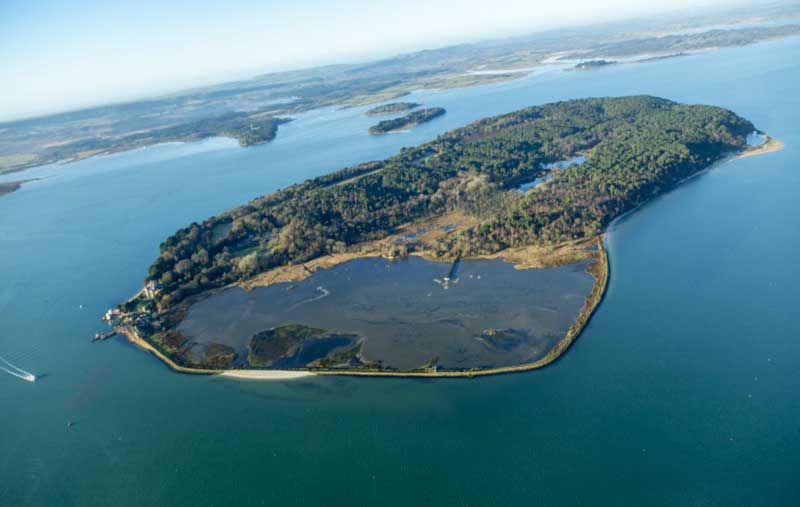
Brownsea Island
Brownsea Island sits in the middle of Poole Harbour, with dramatic views to the Purbeck Hills. Offering a perfect day’s adventure, this island wildlife sanctuary is easy to get to but feels like another world from the moment you step ashore. The island is rich in history too, which is revealed in our Visitor Centre. There are the remains of daffodil farming, pottery works and the village of Maryland to explore, or head to the Outdoor Centre to find out more about the birthplace of the Scouting and Guiding movement. Brownsea Island is serviced by ferry from Poole.
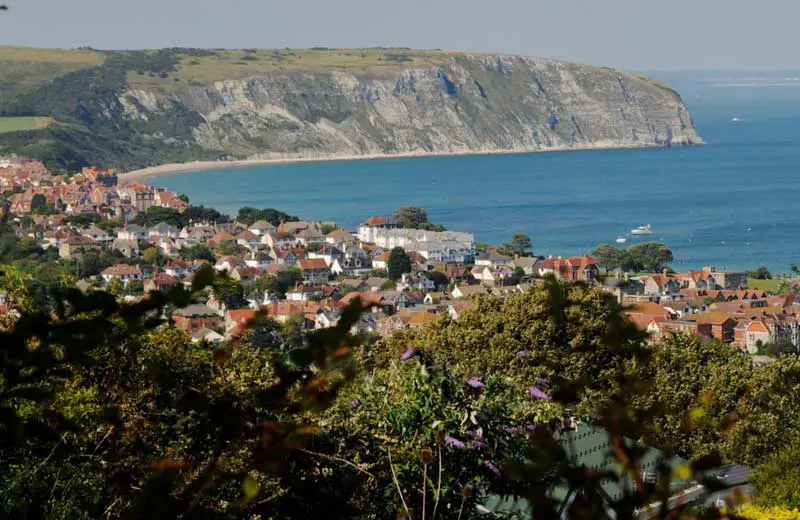
Swanage
The town of Swanage is on the Isle Of Purbeck, a spur of land jutting out into the English Channel. The wide Swanage Bay gives good views to the Isle of Wight in good weather. To the north are chalk cliffs leading to Old Harry Rocks. There are more great views from Durlston Head to the south of the town. Swanage is a small, attractive and friendly traditional seaside town, which nestles in a sandy bay at the foot of the Purbeck Ridge. The town boasts a fine selection of hotels and other accommodation, in addition to many bars, restaurants and cafes. Swanage is an ideal venue for sailing and water sports and its safe bathing make it an ideal family centre. Swanage Railway operates on six miles of track between Swanage and Norden and is a good way in which to explore some of the lovely surrounding countryside.
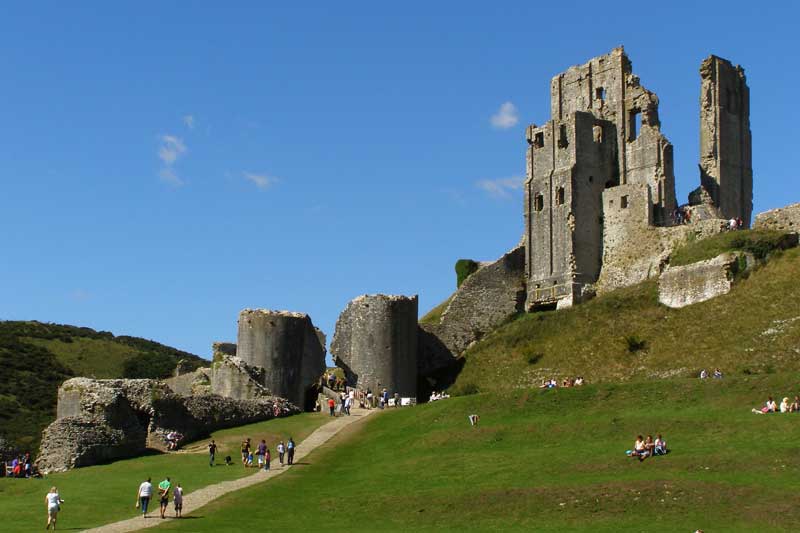
Corfe Castle
There are various other places of interest around Swanage. Perhaps the best known is the quaint village of Corfe and Corfe Castle, scene of one of the great battles of the English Civil War, ending in defeat for the Royalists. The site is believed to have originally been a Roman defensive position, but the castle is known to have been built as a wooden edifice in the 9th century. The present ruins are the remains of the 11th century rebuilt Purbeck Stone castle. The nature reserve of Durlston Country Park on the coast south of Swanage is another place worth visiting, covering more than 260 acres of land. It is home to various species of animals, birds and reptiles. The reserve is popular with bird watchers and there are always sight-seers coming to watch the dolphins in the sea below the park.
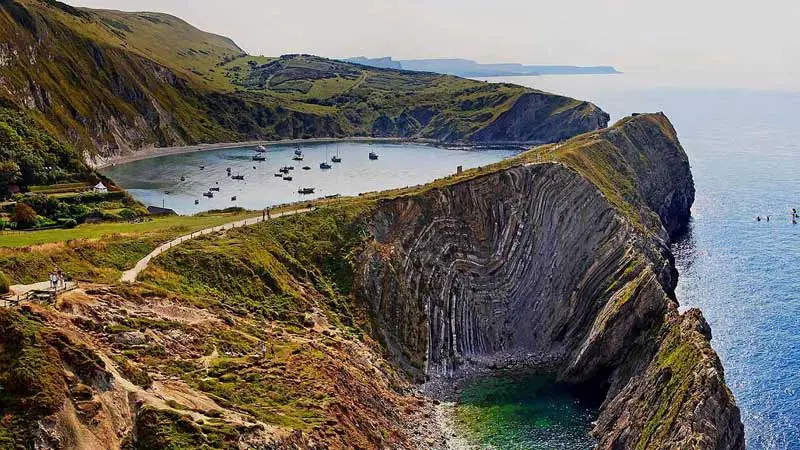
Lulworth Cove
Lulworth acts as a gateway to this part of the Jurassic Coast. Lulworth Cove, near the village of West Lulworth, is one of the world’s finest examples of Jurassic landforms. The cove has formed because there are bands of rock of alternating resistance running parallel to the shore. The entrance to the cove is a narrow gap in the limestone bands formed by a combination of erosional processes from wave action and weathering. Stair Hole, a short walk away, is an infant cove which suggests what Lulworth Cove would have looked like a few hundred thousand years ago. The sea has made a gap in the Portland and Purbeck limestone here, as well as a small arch. Folding can also be seen at nearby Durdle Door and at Lulworth cove itself.
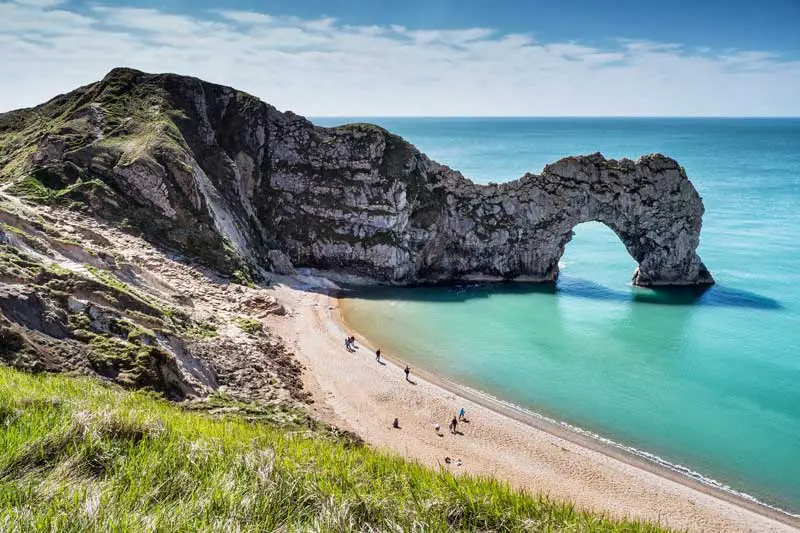
Durdle Door
As well as the cove, across Hambury Tout (the large chalk hill to the west) is Durdle Door, a dramatic and much photographed natural arch. Durdle Door has a sloping beach for bathing or snorkeling from, caves and exciting rock strata. It is a short walk from Lulworth Cove and makes a nice place to have picnic, sunbathe and go swimming. To the east there is a fossilised forest. Lulworth is also close to Kimmeridge, famous for its rocky shore and fossils. The sea floor in and around the cove yields fossils, and oil sands beneath the sea bed form the largest British oil field outside the North Sea area, and contain the highest quality oil in Europe.
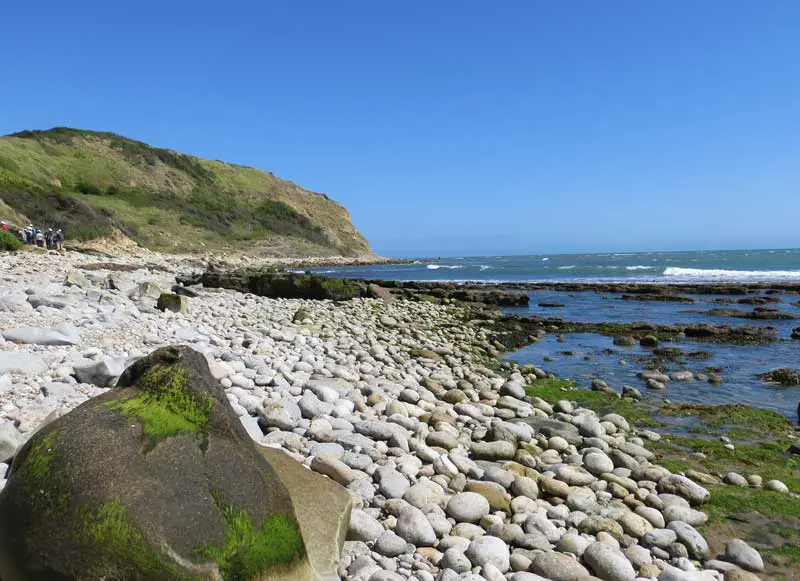
Osmington Mills
The coastal hamlet of Osmington Mills lies about 8 km northeast of Weymouth. The coastline around Osmington Mills is part of Dorset’s Jurassic Coast, and fossils can be found in the cliffs. The rocks consist of Kimmeridge Clay and the Corallian group from the Oxfordian (Upper Jurassic) and have an interesting trace fossil assemblage. To the west are Black Head and beyond that Redcliff Point, with fossils in the Upper Oxford Clay. Osmington Mills is popular with tourists, providing facilities such as camping and caravan sites and attractive coastal walks. Osmington Mills offers picturesque views of the Isle of Portland. A town landmark is the Smuggler’s Inn. Dating back to the 13th century, the inn is known to have been the home of Emmanuel Charles, the leader of the most notorious gang of smugglers in the area during the 18th and 19th centuries.
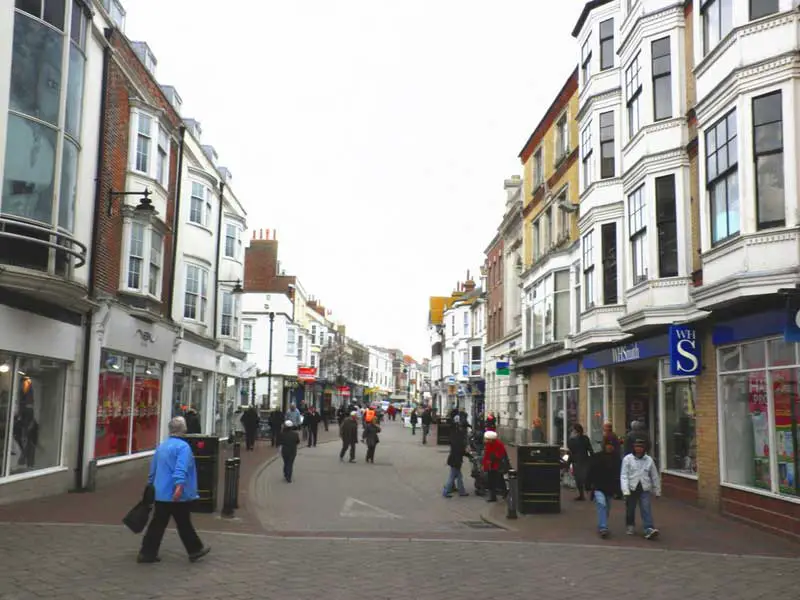
Weymouth
Weymouth is a popular seaside town in Dorset, southern England. Its sandy beach is dotted with colorful beach huts and backed by Georgian houses. Jurassic Skyline, a revolving viewing tower, and Victorian Nothe Fort offer harbour views. Weymouth Sealife Park is home to sharks, turtles and stingrays. On the fossil-rich Jurassic Coast is pebbly Chesil Beach. A causeway leads to Portland Island with its lighthouse and birdlife. In the centre of the town lies Weymouth Harbour; although it was the reason for the town’s foundation, the harbour separates the two areas of Melcombe Regis (the main town centre) and Weymouth (the southern harbourside) from each other.
During World War I, approximately 120,000 ANZAC personnel convalesced in Weymouth after being injured at Gallipoli or other theatres of the war. Weymouth and Portland were bombed by German planes in World War II; Portland harbour had a large naval base, and Weymouth was home to Nothe Fort, next to Nothe Gardens. 517,816 troops embarked through the borough to fight at the Battle of Normandy. The Bouncing bomb was tested in the Fleet lagoon to the west of town. The history of the area is documented at the Timewalk museum in Brewers Quay.
Weymouth Harbour is long and narrow, and formed the estuary of the River Wey until the building of a bridge to Westham, which separated the harbour’s backwaters from Radipole Lake. For centuries the harbour was a passenger terminal and trade and cargo port: goods handled included wool and spices, and in the 20th century Weymouth was a bulk importer of fertiliser and cars. The old harbourside, on both sides of the seaward end of the harbour, still hosts a fishing fleet, with docks, unloading areas, and a cross-channel ferry terminal.
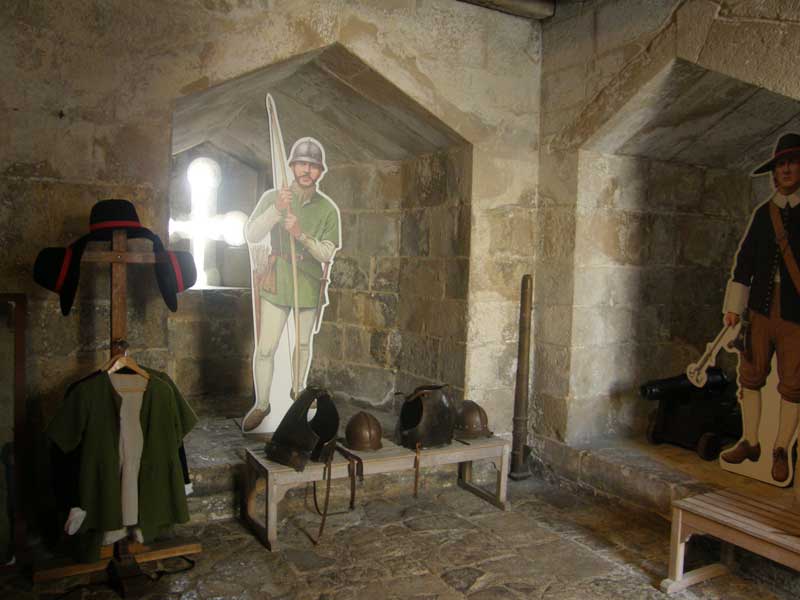
Portland Castle
Located 8 km south of the resort of Weymouth, the Isle of Portland is a central part of the Jurassic Coast. Portland stone, famous for its use in British and world architecture, including St Paul’s Cathedral and the United Nations Headquarters, continues to be quarried. In 1539 King Henry VIII ordered the construction of Portland Castle for defence against attacks by the French. It is one of the best preserved castles from this period, and is opened to the public by the custodians English Heritage. The fan-shaped castle was built from Portland stone, with a curved central tower and a gun battery, flanked by two angular wings. The castle is open for inspection.
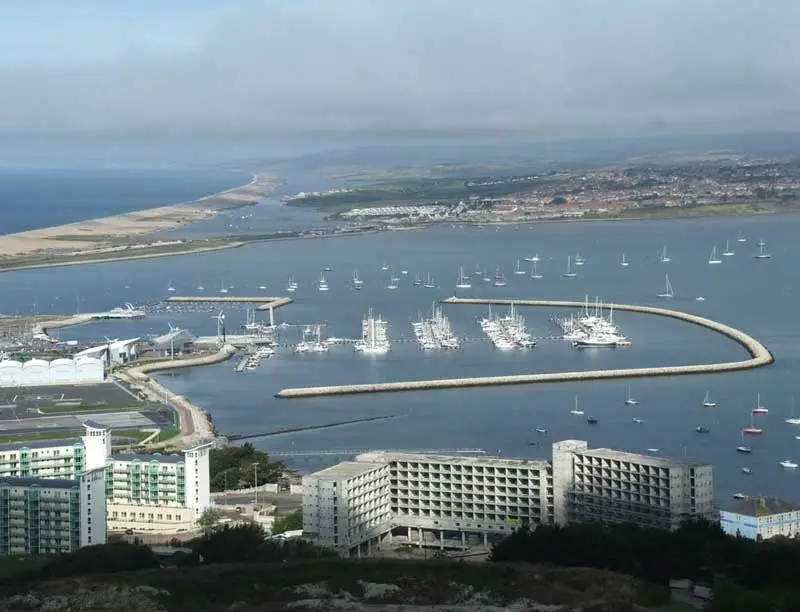
Portland Harbour is located beside the Isle of Portland. It is the second largest man-made harbour in the world, and the largest man-made harbour in Europe. Historically the original harbour was formed by the protection offered by the south coast of England, Chesil Beach and the Isle of Portland. This gave protection from the weather to ships from all directions except the east. The natural shelter was used by ships for centuries, and Romans valued the area’s strategic importance. In the 16th-century, King Henry VIII built Portland Castle and Sandsfoot Castle to defend the anchorage. The harbour is a popular location for wind surfing, wreck diving and sailing. Weymouth and Portland National Sailing Academy which hosted sailing events in the 2012 Olympic Games, is located on the south-western shore of the harbour.
Chesil Beach
Chesil Beach is a long, narrow spit of land reaching 18 miles from Portland Bill to Abbotsbury. Chesil is a steep slope of shingle fronted by pebbles which have been polished smooth by the action of the waves. Visitors can search for “Hag” pebbles, which have a hole bored through them by the natural action of the water. The Chesil Beach Centre near Portland tells the story of the regions unique geology through a series of interactive displays. Visitors can also take a trip on the glass-bottomed Fleet Observer boat to examine the marine world of Chesil more closely. At the eastern end of Chesil Beach is Abbotsbury, famous for its seaside swannery, where you can wander freely among the mute swans that have made this area their home for over 600 years. Nearby is Abbotsbury Gardens, where you can explore 20 acres of rare and exotic plants in a walled garden setting.
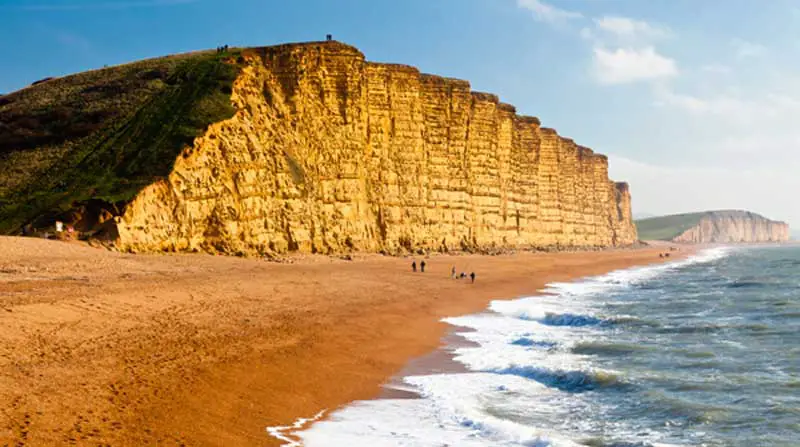
West Bay
West Bay, also known as Bridport Harbour, is a small harbour settlement and resort on the English Channel coast in Dorset. The coast at West Bay forms part of the Jurassic Coast, which includes most of the Dorset coastline. West Bay also lies within the Dorset Area of Outstanding Natural Beauty. The cliffs to the east of the harbour are composed of Bridport Sand Formation and Inferior Oolite, while immediately to the west they are Frome Clay and Forest Marble. The Bridport Sands deposits were laid down in the Toarcian Age toward the end of the Early Jurassic; they are arranged horizontally with clear banding visible. The cliff’s distinctive colour is a result of oxidisation of fine pyrite grains, resulting in limonite. The coast at West Bay is an eroding landscape, with various processes involved in keeping it stable.
West Bay beach was used in the introduction to the BBC television series The Fall and Rise of Reginald Perrin and for location filming in the television series Harbour Lights. The town, harbour, and beach were used as locations in the 2013 TV series Broadchurch.
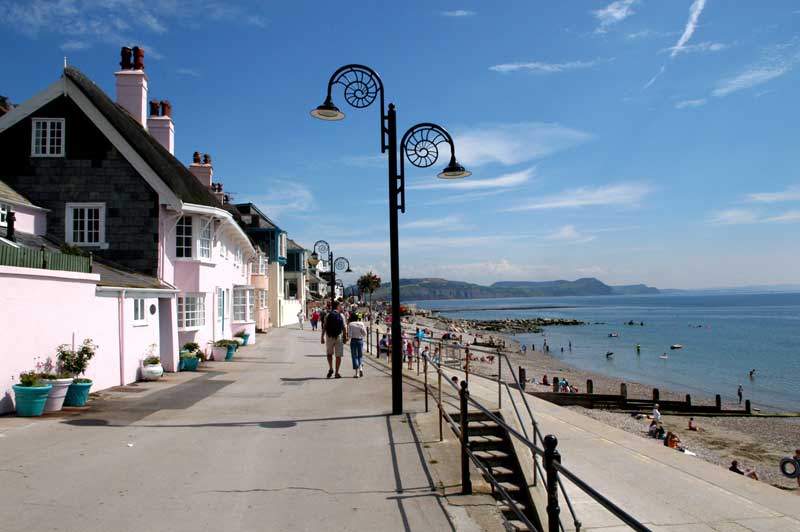
Lyme Regis
Lyme Regis is lovely old port, most famous recently as the scene of John Fowle’s novel, The French Lieutenant’s Woman. The cliffs around Lyme Regis have yielded a vast number of fossils (mostly marine fossils). The cliffs are given to landslips, so care should be taken, especially in wet weather, when the undercliffs may become unstable. The Lyme Regis Marine Wildlife Area extends for 7 km from Humble Point to Charmouth, and is home to a huge variety of marine wildlife, including seaweeds, algae, limpets, winkles, crustaceans, and the carnivorous dogwhelk. The Heritage Coast Centre in Charmouth is an excellent place to learn about the unique geology and geography of this area.
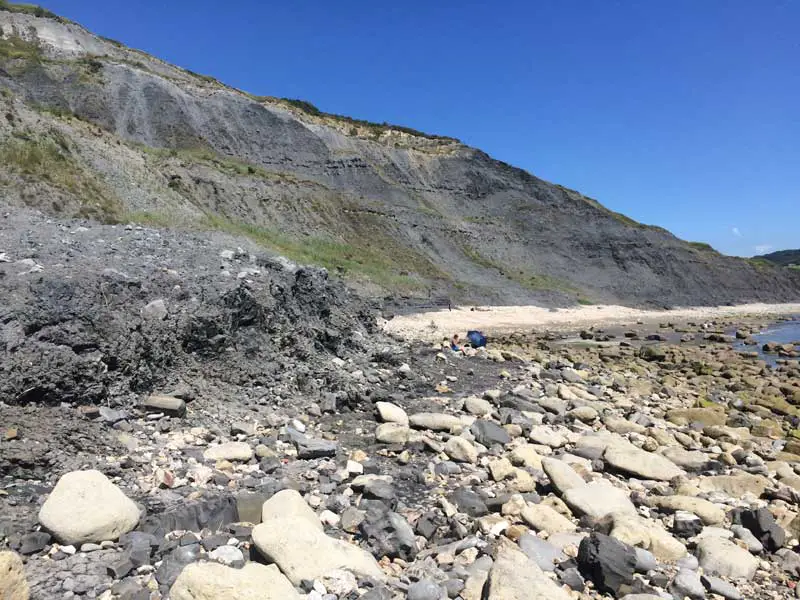
The Axmouth to Lyme Regis Undercliffs
Between Axmouth in East Devon and Lyme Regis in Dorset the geology of the coast has helped create one of the great wilderness areas of southern England, now a National Nature Reserve. Sandstone and chalk slipping over clay and limestone has left a ragged coastline dissected by some of the largest coastal landslides in the country. Weaving its way through all this is the South West Coast Path. Making your way along it involves traversing some pretty rough terrain as the path crosses the slipped and torn landscape of the undercliffs, but it is worth it. There are few opportunities to encounter nature so untamed and here, more than any other part of the Jurassic Coast, there is a sense that people are only passing through, guests of the wild inhabitants who are the true owners of this place.
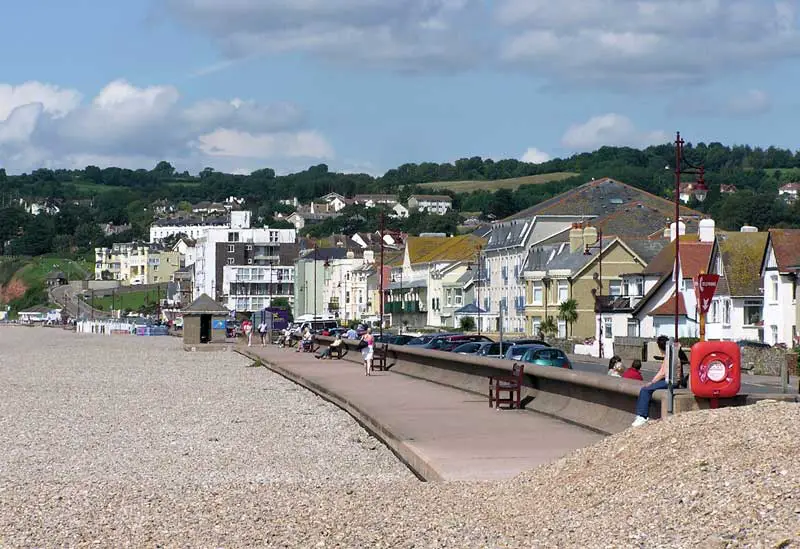
Seaton
The small seaside town of Seaton faces onto Lyme Bay, to the west of the mouth of the River Axe with red cliffs to one side and white cliffs on the other. Seaton sits on the Dorset and East Devon Coast World Heritage Site, more commonly known as the Jurassic Coast. From Seaton it is possible to visit rock strata dating from three geological periods in a 185 million-year geological walk through time. In the 19th century Seaton developed as a holiday resort, which it remains to this day. Seaton lost its largest holiday camp at the beginning of 2009 when the site was purchased by Tesco who opened a major supermarket on the site in late 2011. However, Seaton still has many accommodation providers including guest houses, hotels, a camping site and a caravan park. Seaton Jurassic visitor centre tells the story of the Jurassic Coast.
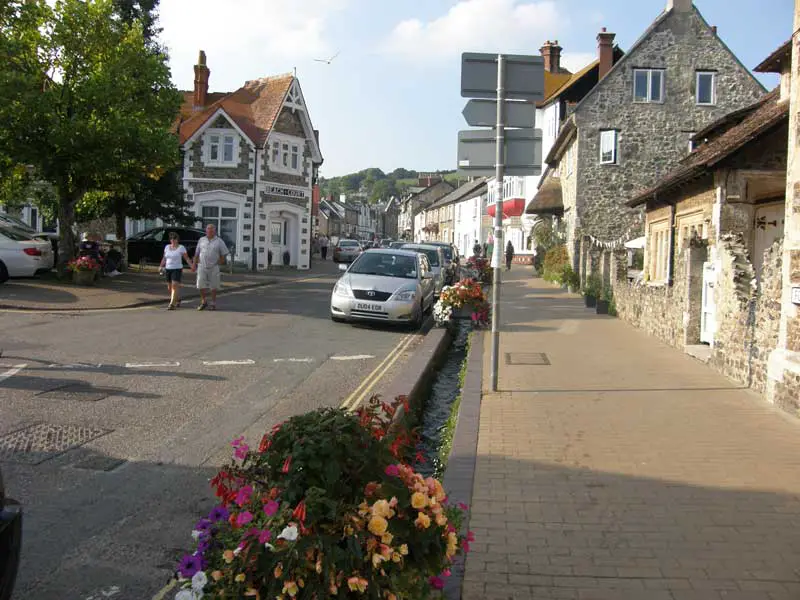
Beer
The picture-postcard village of Beer, Devon nestles in Lyme Bay, and forms part of the South West Coastal Path. The shingle beach still boasts a small fleet of working fishing boats and the surrounding picturesque white chalk cliffs provide a natural suntrap sheltering the cove from prevailing westerly winds. The Axe Estuary, with its areas of grazing marsh, and the River Axe itself, are of international importance for their aquatic communities. To the east lies the Axmouth to Lyme Regis Undercliffs National Nature Reserve. This large area of coastal landslides and cliffs supports important woodland and grassland habitats and is of considerable significance for its geology, as witnessed by its inclusion in the Jurassic Coast World Heritage Site. The Beer Heights Light Railway, along with numerous model railways are part of Pecorama, a tourist attraction provided by the model railway manufacturer Peco.
Branscombe
Branscombe is one of the most relaxing and picturesque villages on the South-East Devon’s Jurassic Coastline. Believed to be the longest village in the country, it sweeps down along a spectacular valley, past colourful cottages down to the sea. There are pretty rows of thatched cottages with hanging baskets and climbing roses, a picturesque dovecote and a church with one of the most inspiring views in the county, if not further afield. The surrounding countryside is a walkers delight. You can follow a spectacular coastal path from Sidmouth to the west and Beer to the east, a walk that takes about half a day. The land around the beach is owned by the National Trust and although you have to pay car parking charges, the long expanse of pebbles and painted coastal huts, are worth it.
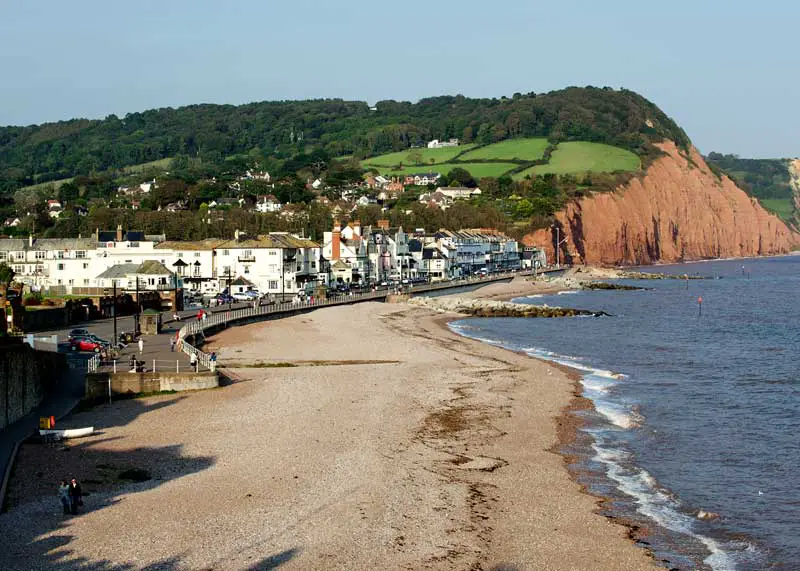
Sidmouth
Situated 23 km east of Exeter, Sidmouth is a tourist resort and a gateway to the Jurassic Coast World Heritage Site. A large part of the town has been designated a conservation area. Connaught Gardens date from around 1820. They were named after the Duke of Connaught, the third son of Queen Victoria and he officially opened the gardens in 1934, aged 84. They contain a bandstand opening to a wide space and is used by bands in many weeks of the summer season. Jacob’s Ladder is a series of wooden steps leading up to Connaught Gardens from Jacob’s Ladder beach and its red cliffs. An alternative route up to Connaught Gardens is a steep path. The ladder became unstable and began to become crooked. It was repaired by a team.

Budleigh Salterton
The small town of Budleigh Salterton lies on the South West Coast Path, with clifftop routes eastwards to Sidmouth and westwards to Exmouth. The pebble beach and cliffs are part of the Jurassic Coast World Heritage site. To the south west are the picturesque Devon Cliffs, where there is a popular holiday park atop the cliffs. At the foot of the cliffs is Sandy Bay, which, as its name suggests, is a sandy beach. Its 1.6 km long strip of sand is connected to the beach at Exmouth at low tide. Just west of Sandy Bay are Orcombe rocks, a heritage site well known for its fossils. To the east is Straight Point, this headland is used by the Royal Marines as a firing range. Further to the east is Otter Cove, Littleton Cove and the village of Budleigh Salterton.
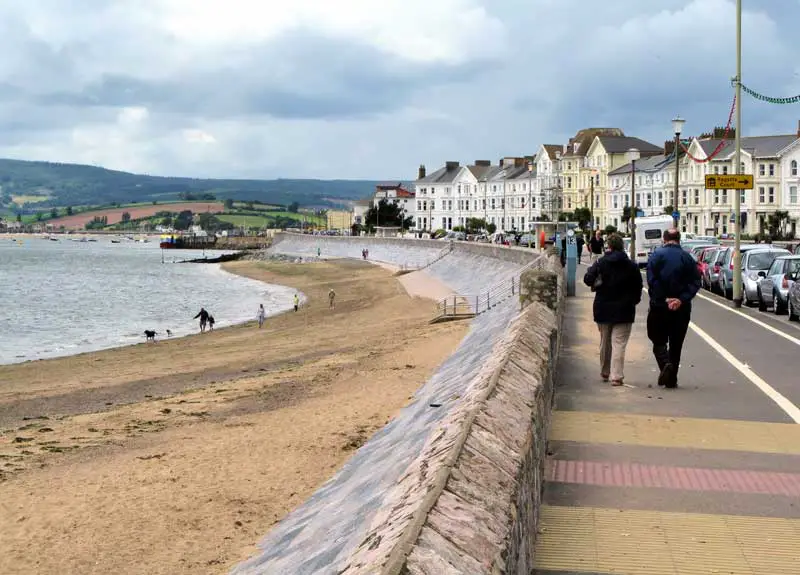
Exmouth
Exmouth is a port town, civil parish and seaside resort in East Devon, sited on the east bank of the mouth of the River Exe. In 2011, it had a population of 34,432 making Exmouth the 5th most populous settlement in Devon. Kite surfing, Kayaking or Windsurfing, cycling and bird watching are enjoyed on the Exe estuary. Exmouth is a popular base to enjoy the best of Devon and the Westcountry.
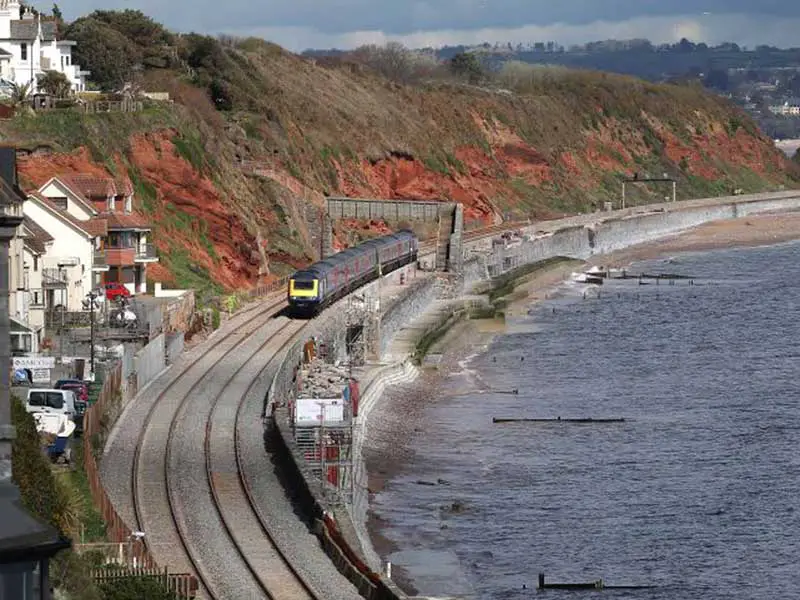
Dawlish
Dwalish is a pristine seaside resort in the true Victorian tradition of railway, buckets and spades and a promenade. This town is a unique take on the traditional beach holiday, with a real community feel to the town and all the traditional excitement of the sand and the sea. Dawlishis notabe for its long sandy beach, which provides the perfect way to spend a summer’s day swimming, exploring rock pools or boating. The town has plenty of interesting shops and a pleasant park where you can see the famous black swans of Dawlish glide sedately along the river.
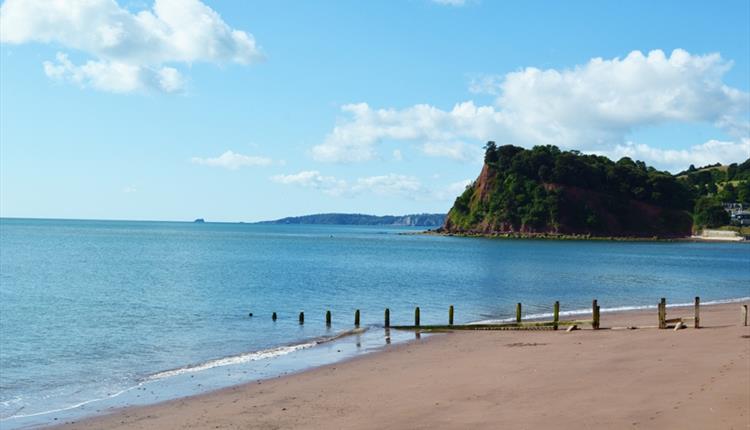
Teignmouth
With a classic crescent of Georgian buildings, promenade and long sandy beach Teignmouth is a real hidden gem on the South Devon coast and is both a historic port and classic seaside holiday resort. With traditional seaside holiday attractions all around you won’t need to venture far to keep everyone entertained. Teignmouth sits at the end of the Templer Way, an 30 km walking trail which traces the historic line of granite being taken from the quarries at Haytor to the docks at Teignmouth. The walk follows the Stover Canal, where possible, and is one of many scenic footpaths covering South Devon.
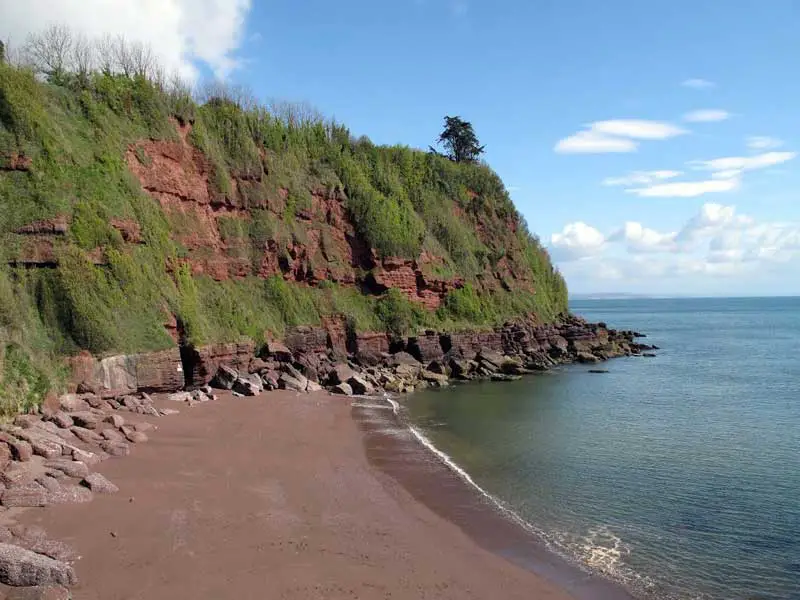
Maidencombe Beach
If you’re looking for a quiet haven to spend the day, Maidencombe Beach is the perfect retreat. Far removed from amusement arcades and water parks, Maidencombe Beach is about one thing: relaxing. The beach is situated on a particularly beautiful stretch of the South West Coastal Path, with a safe and well signposted path for you to follow. Along the walking trails you’ll find beautiful flora and fauna, wildlife and panoramic vistas.
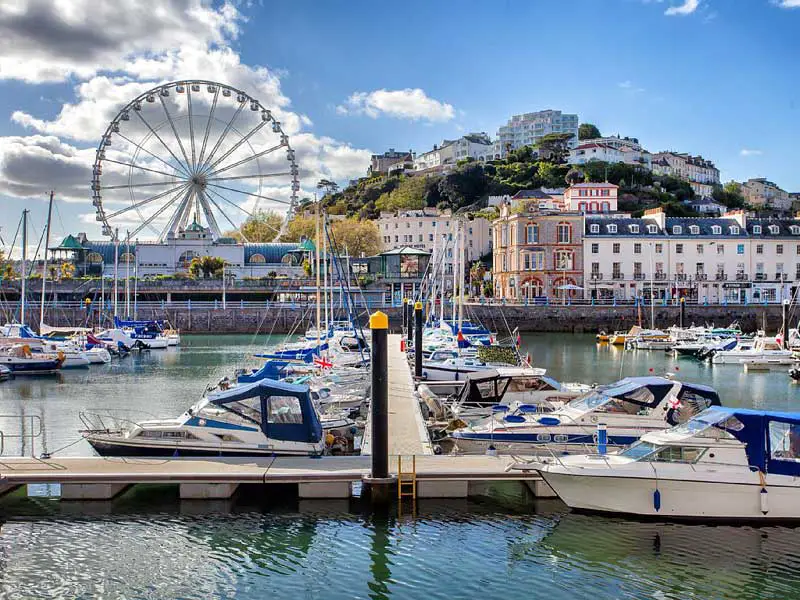
Torquay
The seaside resort town Torquay on the English Channel in Devon, has a reputation of being the capital of the coastline is nicknamed the English Riviera. Torquay Harbour near the town centre offers shops, cafes and a marina. Torre Abbey, a monastery founded in 1196, has art galleries and extensive gardens featuring plants from local native Agatha Christie’s novels. Torquay was the home of the writer Agatha Christie, who was born in the town and lived there during her early years. The town contains an “Agatha Christie Mile”, a tour with plaques dedicated to her life and work. The town’s economy, like Brixham’s, was initially based upon fishing and agriculture, but in the early 19th century the town began to develop into a fashionable seaside resort, initially frequented by members of the Royal Navy during the Napoleonic Wars while the Royal Navy anchored in the bay. Later, as the town’s fame spread, it was popular with the creme de la creme of Victorian society.
Torquay has numerous tourist attractions, including Kents Cavern, Britain’s most important Stone Age site, which was home to early man for some 40,000 years. Living Coasts, a coastal zoo owned by Paignton Zoo, is built on Beacon Quay which has existed since 1680. Britain’s Largest Model Village is located at Torquay. Babbacombe Model Village Torquay features a model railway, thousands of miniature buildings, people and vehicles, along with animated scenes and touches of English humour, capture the essence of England’s past, present and future. Built in 1926, the Babbacombe Cliff Railway has shuttled hundreds of thousands of holiday makers to and from Oddicombe Beach in over 84 years of service. The Cliff Railway provides a vital and non-exhausting way for locals and holiday makers alike to soak up the peaceful atmosphere and take in the amazing views as they travel to and from the water’s edge.
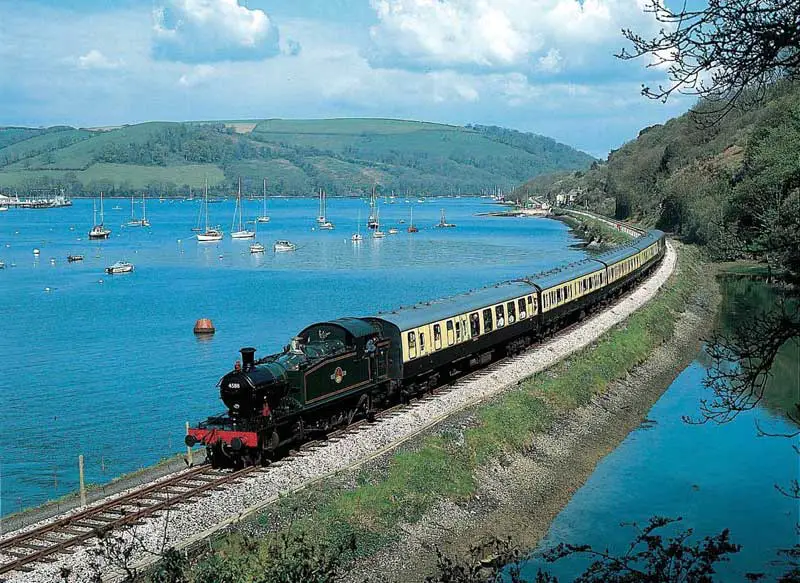
Paignton
Along with Torquay and Brixham, the seaside town of Paignton orms the unitary authority of Torbay. Located on the coast of Tor Bay in Devon, Paignton is one of the jewels in the English Riviera’s crown. one of One of the town’s many Paignton attractions is Paignton Zoo. Paignton is home to the Dartmouth Steam Railway. Setting off from Paignton along one of the most idyllic stretches of coastline in the country, you’ll head for the pretty village of Kingswear where you can relax in the sunshine and enjoy an alfresco lunch.
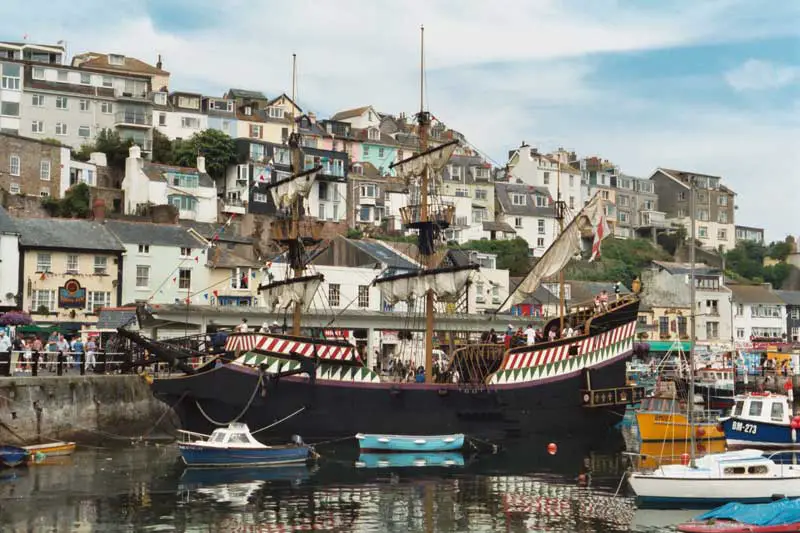
Brixham
The picturesque town of Brixham still has a working harbour with fishing fleet, which is surrounded by lots of shops, restaurants, pubs, etc. and of course many quant fisherman’s cottages. A short stroll from the harbour, Breakwater Cove, with its imposing breakwater, penetrates into the sea for over a kilometre. Brixham has four other coves, Shoalstone Cove, Fishcombe Cove, Churston Cove and St Marys Bay.
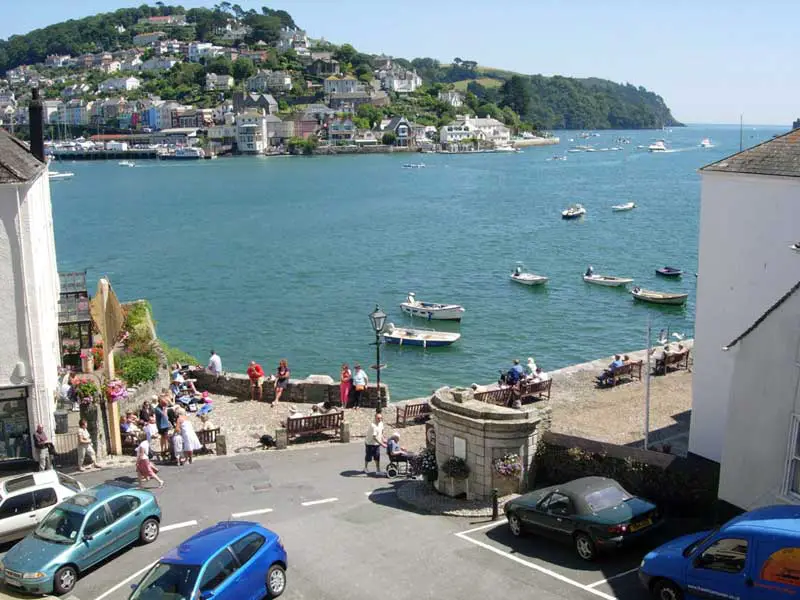
Dartmouth
Situated at the mouth of the River Dart, opposite the picturesque village of Kingswear, is the historical town of Dartmouth. Its enchanting streets and scenic river location make it a pretty lovation. Overlooking one of the finest natural harbours in the UK, Dartmouth has a strong maritime heritage and is packed with events and things to do throughout the year, from sailing to arts and cultural festivals. Lying in the South Devon Area of Outstanding Natural Beauty, the town has a vibrant, coastal charm and is well served by ferry and coastal path links.
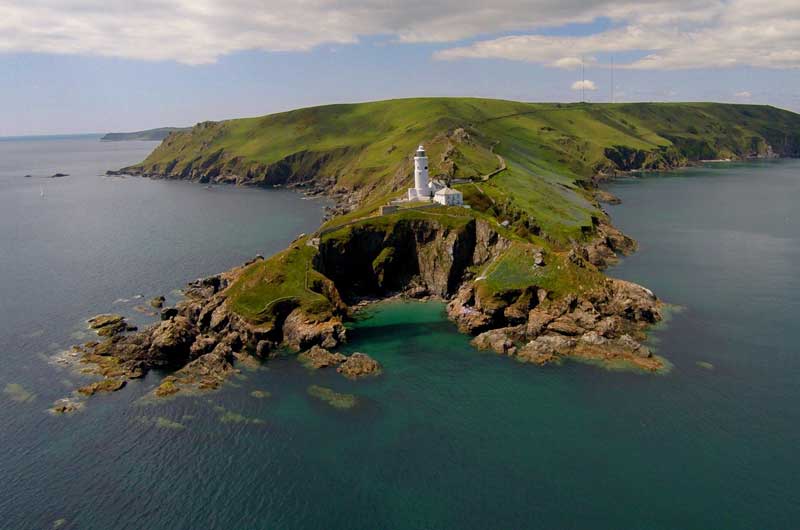
Start Point
Start Point is a spectacular promontory in South Hams, south Devon on the most southerly headland in the county. It marks the western side of Start Bay which extends eastwards to the River Dart estuary. The jagged ridge of this headland is mirrored by dangerous rocks lying under the water including Black Stone rock. These rocks, combined with the strong tidal race around the tip of the headland, make Start Point a very dangerous spot for shipping. Following countless shipping disasters and heavy loss of lives, the lighthouse flashed its warning for the first time in 1836. Start Point is one of the most Southerly points in picturesque South Devon. Start Point is on the South West Coast Path and is a very enjoyable walk from Torcross (approx 2 hours) or Beesands (approx 1.5 hours) past the lost village of Hallsands from the East and East Prawle (approx two hours) and Salcombe (approx four hours) from the West.
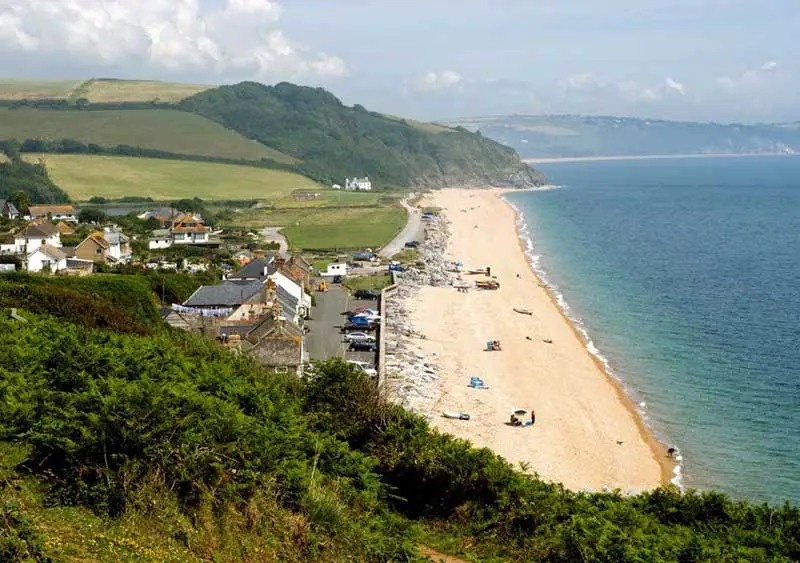
Beesands
Beesands is a small settlement located midway between Hallsands and Torcross on the coast of Start Bay. It is best known as a tourist destination, but is still a fishing village that concentrates mainly on crab and lobster fishing. There is an Anglican chapel dedicated to St Andrew in the village. Behind the beach, north of the settlement is a freshwater lake known as Beesands Ley, smaller but similar in ecology to Slapton Ley about a kilometre to the north. The family of The Rolling Stones’ Keith Richards regularly spent holidays at Beesands during the 1950s. Richards and Mick Jagger’s first public performance was at The Cricket Inn in the village.
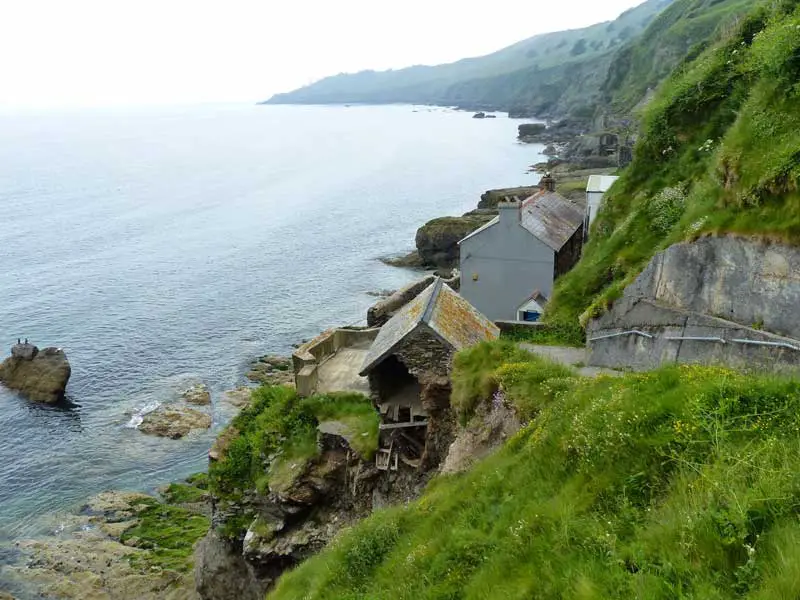
Hallsands
The village and beach of Hallsands in south Devon, sits in a precarious position between cliffs and the sea, between Beesands to the north and Start Point to the south. The site of the old village at South Hallsands, is closed, although there is a viewing platform, which is accessed from Trout’s Apartments in South Hallsands. Two houses remain intact, but in summer the owners spend much time repairing the damage that the easterly winds have caused over the winter. The beach at North Hallsands, known locally at the time as “Greenstraight”, was for 99 years the only one remaining at Hallsands, as the beach beside the village no longer exists, having been removed by the 1917 storm. In 2016 this beach was reported to have been washed away by storms, leaving only a peat underlayer; there are no plans to restore the sand or protect houses in the village.
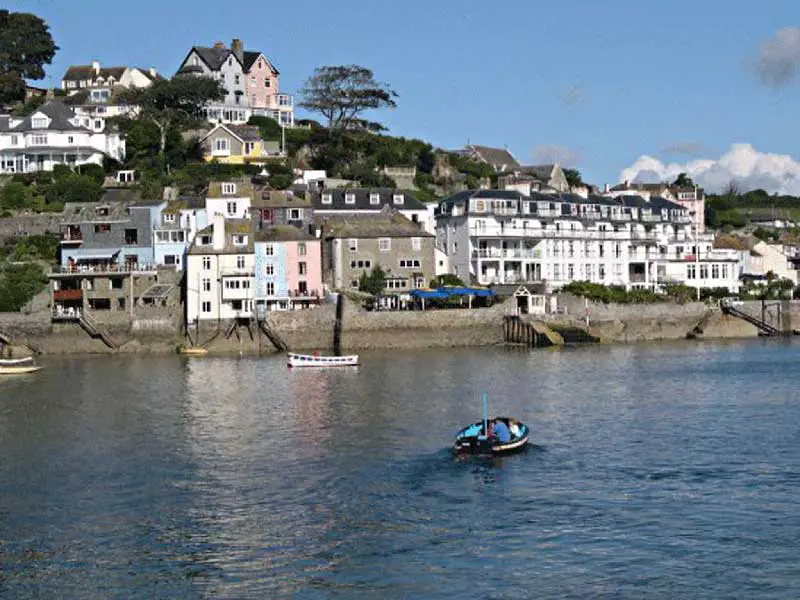
Salcombe
Salcombe is a popular resort town in the South Hams district of Devon. The town is close to the mouth of the Kingsbridge Estuary, mostly built on the steep west side of the estuary. It lies within the South Devon Area of Outstanding Natural Beauty (AONB). The town’s extensive waterfront and the naturally sheltered harbour formed by the estuary gave rise to its success as a boat and shipbuilding and sailing port and, in modern times, tourism especially in the form of pleasure sailing and yachting. There are a number of shipwrecks off Salcombe. One is of a Bronze Age ship, one of only three known in Britain, which had weapons and jewellery made in what is now France. The Salcombe Maritime Museum, founded in 1975, has information on fruit schooners and other items of interest.
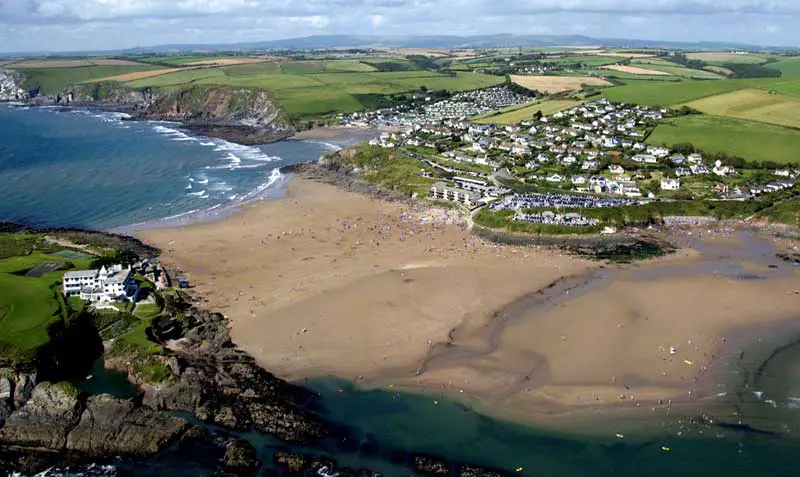
Bigbury-on-Sea
The village of Bigbury-on-Sea in the South Hams district on the south coast of Devon is on the coast above the largest sandy beach in South Devon facing south to Bigbury Bay. The tidal island of Burgh Island lies about 250 metres offshore. At the start of the 20th century Bigbury-on-Sea consisted of a few fishermen’s cottages with fish cellars. The village grew with the growth in holidaymaking and now has a beach cafe, and by the mainland side of causeway is the Burgh Island Causeway resort built in 1998. The resort is made up of privately owned and holiday let flats and a private leisure club with indoor pool and gym. The Devon Coastal Path runs behind the resort. There are two large car parks with easy access to the beaches and the walk across the sand bar to Burgh Island with its Art Deco Hotel and Pilchard Inn. When the tide covers the sand bar access is by the sea tractor.

Burgh Island
There are several buildings on Burgh Island, the largest being the Burgh Island Hotel. Burgh Island is closely linked to Agatha Christie, as it served as the inspirational setting for Soldier Island (And Then There Were None) and for the setting of the Hercule Poirot mystery Evil Under the Sun. The hotel, with its Art Deco styling, was also a bolt hole in the 1930s for some of London’s rich and famous, including Noel Coward. The 2002 TV adaptation of Evil Under The Sun used the island as a filming location.
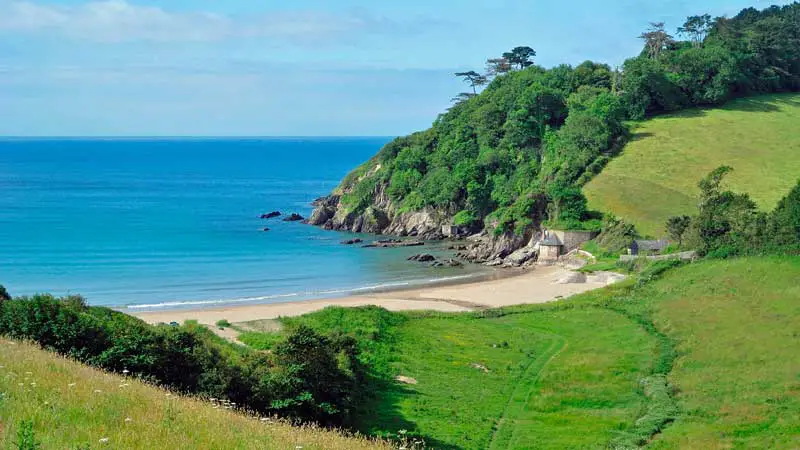
Mothecombe Beach
If you are looking for a beach without the crowds, Mothecombe beach is one of the quieter beaches in South Devon. Large and unspoilt, it is privately owned but open to the public on Wednesdays, Saturdays and Sundays. The owners have won an award from the Marine Conservation Society for keeping the sea and sands clean, and at low tide Mothecombe comes into its own with fine sand and plenty of opportunity for shallow, sheltered bathing.
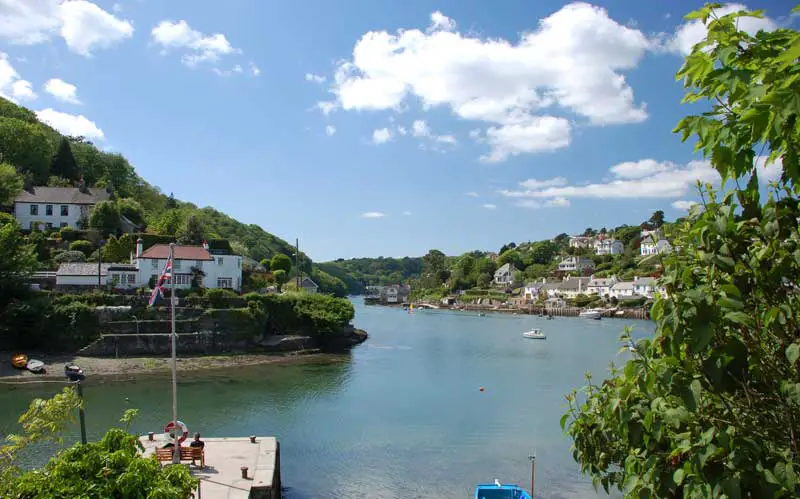
Newton Ferrers
The quiet village of Newton Ferrers is about 10 km south-east of Plymouth on the River Yealm estuary. It lies within the South Devon Area of Outstanding Natural Beauty. The church of Holy Cross in Newton Ferrers was re-built in 1260. It was less than half the size of the present building and in 1342 was enlarged by the then rector, Henry de Ferrers. Across the creek, St. Peter’s at Noss Mayo was built in 1877 by Edward Baring, the 1st Lord Revelstoke, and took over from the nearby Church of St Peter the Poor Fisherman, Revelstoke, built in 1226.

Plymouth
A major city of over 260,000 people on the south coast of Devon, Plymouth is a comfortable size for visitors to handle and find their way around easily. It has plenty in terms of history and natural attractions to offer the visitor and is often used as a base by visitors to Dartmoor, the Tamar Valley and the beaches of south-east Cornwall. Plymouth railway station, which opened in 1877, is managed by Great Western Railway and also sees trains on the CrossCountry network. It has a direct rail link to London. Smaller stations are served by local trains on the Tamar Valley Line and Cornish Main Line.
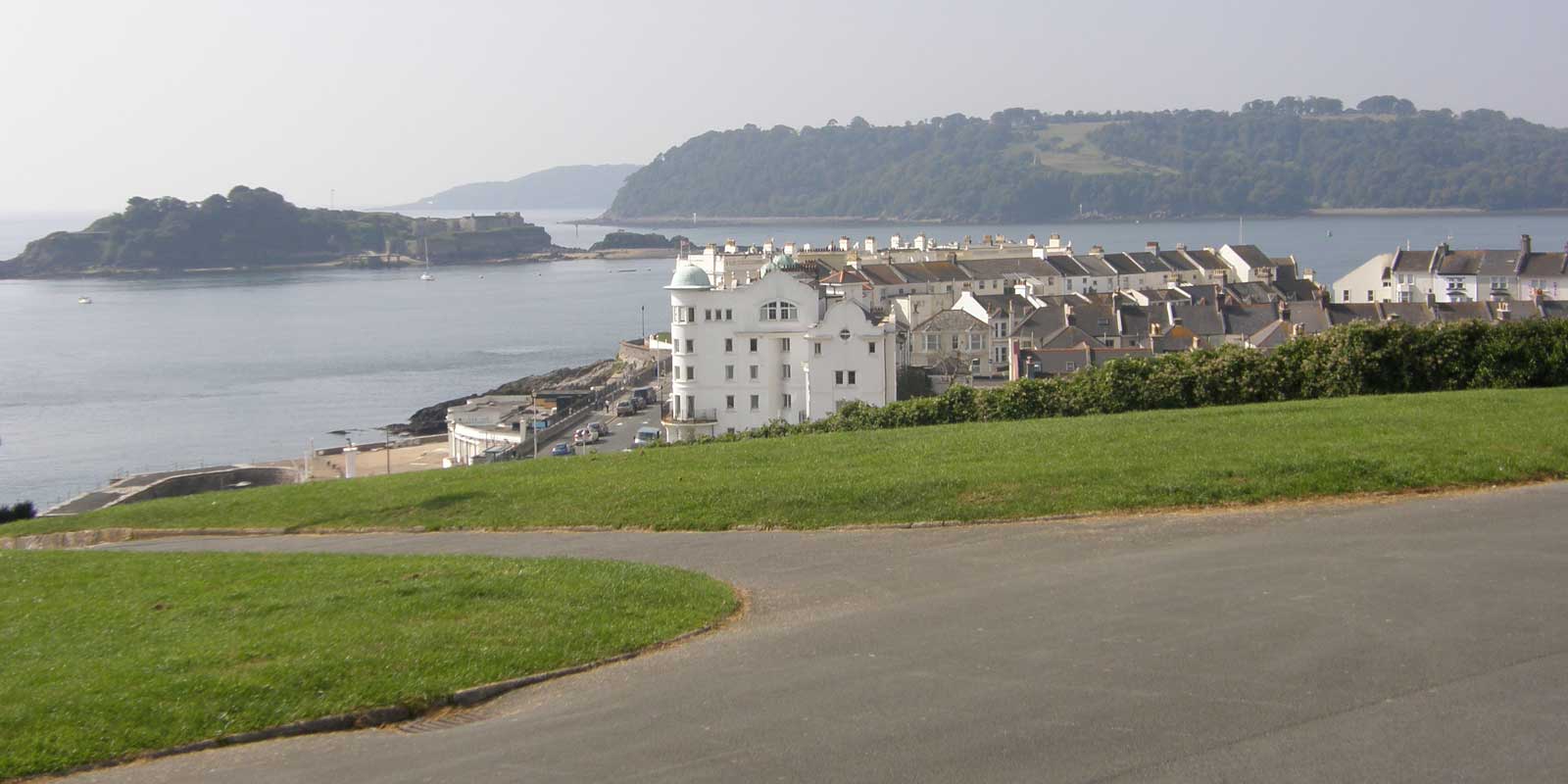
Plymouth Hoe
Plymouth has long played a role in Britain’s maritime history. In 1620, the Pilgrim Fathers departed Plymouth for the New World and established Plymouth Colony – the second English settlement in what is now the United States of America. They left near the commemorative Mayflower Steps in Sutton Pool. During the English Civil War the town was held by the Parliamentarians and was besieged between 1642 and 1646. Throughout the Industrial Revolution, Plymouth grew as a commercial shipping port, handling imports and passengers from the Americas, and exporting local minerals (tin, copper, lime, china clay and arsenic) while the neighbouring town of Devonport became a strategic Royal Naval shipbuilding and dockyard town.
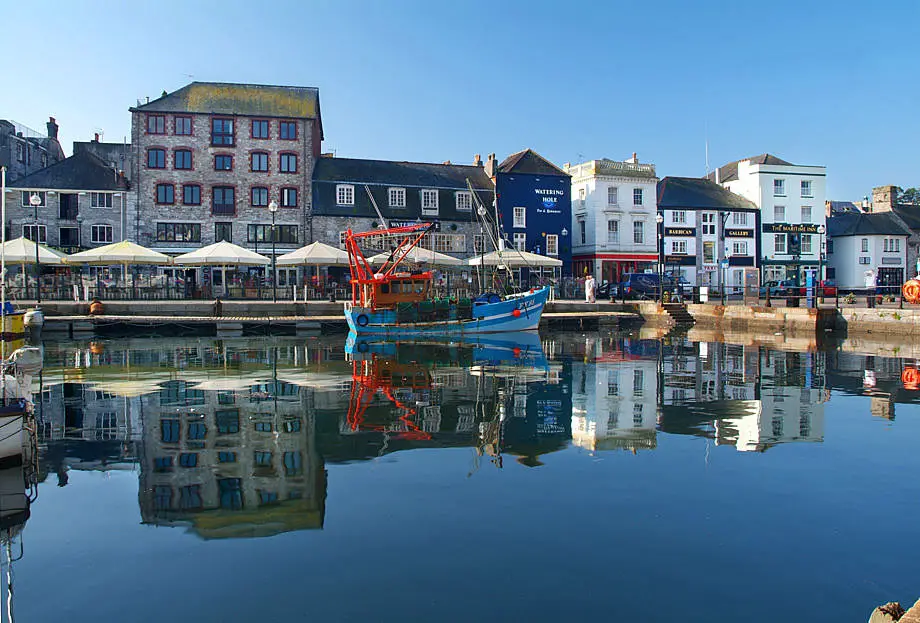
After the English Civil War the Royal Citadel was built in 1666 on the east end of Plymouth Hoe, to defend the port from naval attacks, suppress Plymothian Parliamentary leanings and to train the armed forces. Guided tours are available in the summer months. Further west is Smeaton’s Tower, which was built in 1759 as a lighthouse on rocks 14 miles (23 km) off shore, but dismantled and the top two thirds rebuilt on the Hoe in 1877. It is open to the public and has views over the Plymouth Sound and the city from the lantern room. Plymouth has 20 war memorials of which nine are on The Hoe including: Plymouth Naval Memorial, to remember those killed in World Wars I and II, and the Armada Memorial, to commemorate the defeat of the Spanish Armada.
Design by W3layouts
